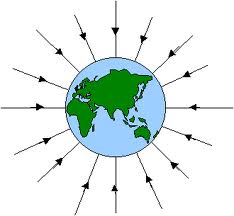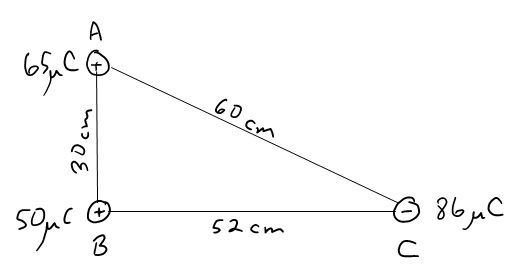1 - Review of Gravitational Force and Field
Recall that a gravitational force only exists if there are two masses. The gravitational force is the force of attraction between these two masses. The relationship between these masses and the force is given by Newton's Universal Law of Gravitation:

Newton's 2nd Law of Motion gives us another expression between force (weight) and mass, where the acceleration in this case is that measured to be gravity, g:
We can combine these two formulas by realizing that Force = Force. We then solve for g, now called the gravitational field strength, measured in units of N/kg:


Gravitational potential energy, Ep, is defined with the following expression, where the "-" is used to show that the energy increases to zero as the distance from the mass, r, increases to infinity.

Gravitational potential, V (measured in J/kg) is sometimes more useful than potential energy. The formula for this is:

Electric Charge
There are two types of electric charge in the universe. These were arbitrarily called "+" and "-" by the scientists who did early electricity experiments. We now know that these charges are carried by various sub-atomic particles like the electron and the proton. (There are other charged particles too - the positron and the muon for example.)
Since charge is a property carried by a little piece of matter, and these little pieces of matter move, it is possible for charge to be transferred between objects. You experience this when you get a static shock or when your socks stick to your shirt when they come out of the dryer.
Law of Conservation of Charge
- The net amount of charge produced in any process is zero.
- Charges can be transferred from one object to another, but no charges are created or destroyed in the process. You begin and end with the same amount of charge.
Measuring Charge
The symbol for charge is q. Charges can be positive or negative.
Charge is measured in unit called Coulombs which has the symbol C.
1 C of charge is a huge amount of charge. Generally you will be measuring or calculating with charges measured in micro-Coulombs ( µC) or in nano-Coulombs. (nC).
The charge on an electron is the smallest amount of charge possible. An electron is denoted with the symbol e-.
![]()
The charge of a proton is equal in magnitude but opposite in sign to that of an electron. A proton is denoted sometimes with the symbol p and sometimes with the symbol e.
![]()

Opposites Attract
Charges exert forces on other charges. This force acts over a distance - no touching. These electric forces behave like magnetic forces. Sometimes the force is attractive and sometime repulsive.
Coulomb's Law
- opposite charges attract each other
- like charges repel each other
- the magnitude of the force acting between the charges is directly related to the magnitude of the charges and inversely related to the square of the distance between the charge

- where Q and q are the two charges
- r is the distance between the two charges
- and k is a constant called the Coulomb Constant with a value of . . .

(Compare this formula to that for Newton's Law of Universal Gravitation.)
Examples
- Calculate the average force of attraction between an electron and a proton in a hydrogen atom.
- How many electrons make up a charge of -30.0 µC?
- Particles of charge +70, +48, and -80 µC are placed in a line as shown in the figure. The center one is 0.35m from each of the others. Calculate the net force on the leftmost charge due to the other two.

- Three charged particles are arranged in a triangle as shown in the figure below. Find the net electric force on particle A.

(Click here for solutions.)